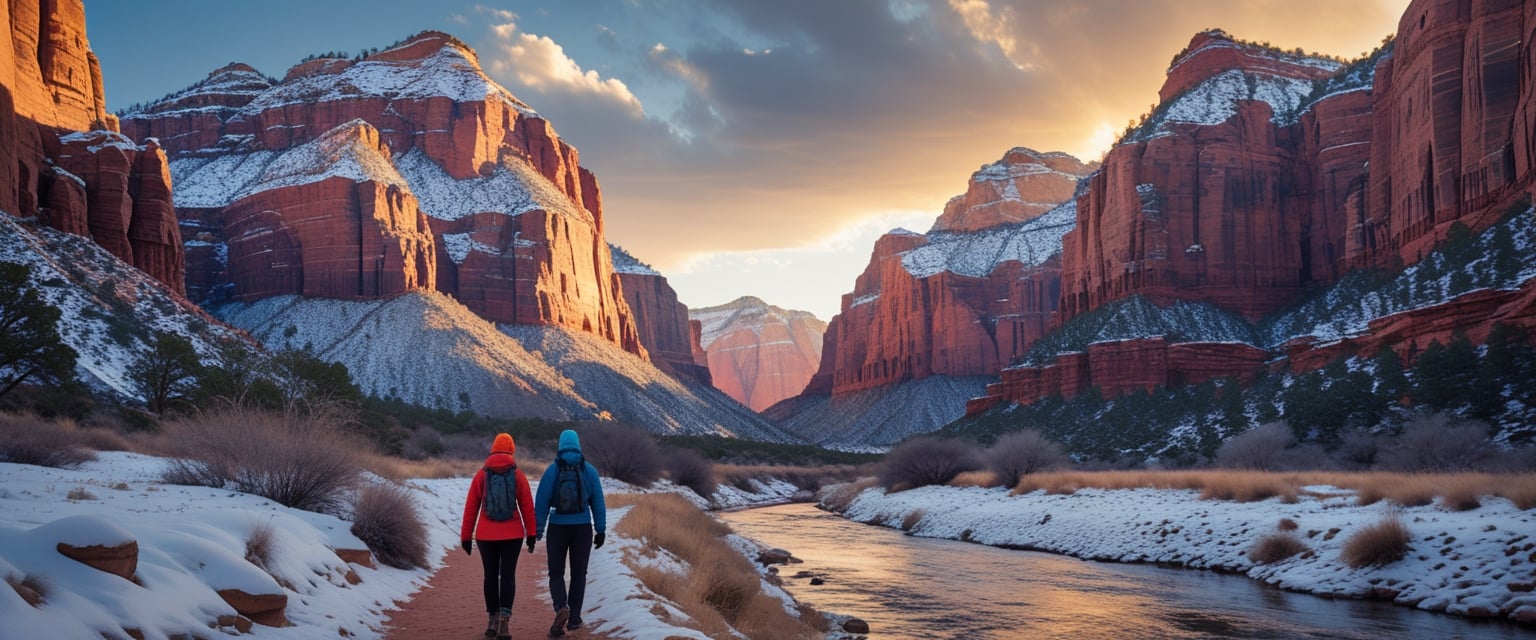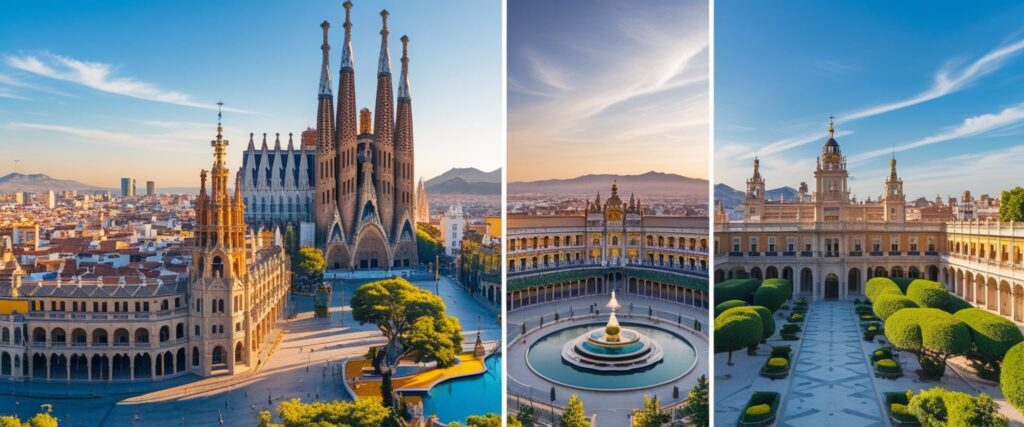Planning a winter adventure to Zion National Park in December offers travelers a truly unique experience filled with snow-dusted cliffs, serene trails, and fewer crowds. Unlike the busy summer season, visiting Zion National Park in December gives you the chance to explore the red rock landscapes at a calmer pace. Many visitors choose Zion National Park in December for its peaceful hiking conditions, scenic drives without shuttle restrictions, and affordable lodging options.
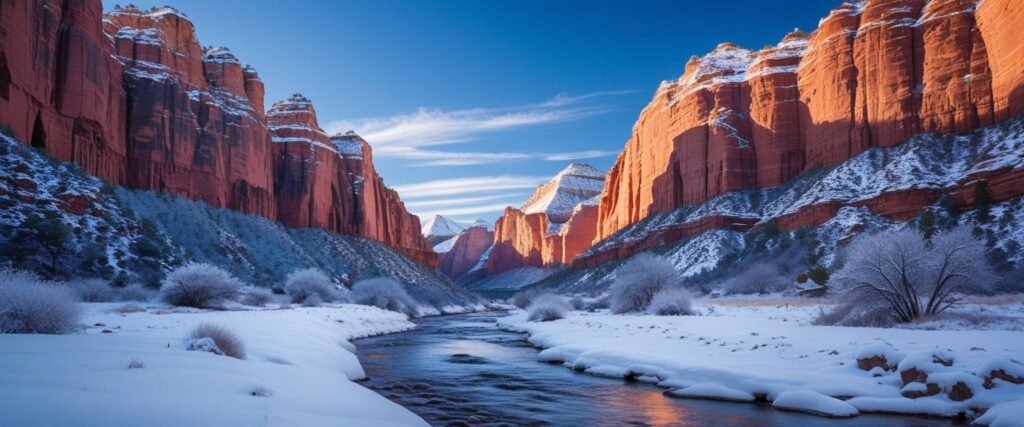
The crisp air, clear skies, and striking contrasts of snow against sandstone make Zion National Park in December a paradise for photographers and nature lovers. Whether you’re seeking the best hikes, family-friendly walks, or guided tours, Zion National Park in December delivers a mix of beauty and accessibility. For those wondering about the nearest airports and travel routes, this guide provides practical tips to make your trip to Zion National Park in December seamless and memorable.
Table of Contents
Zion National Park in December
Zion National Park offers striking red rock cliffs, narrow slot canyons, and some of the most popular hikes in the United States. The closest major airport to Zion is Las Vegas McCarran International Airport, about a 2.5-hour drive away, making it the most convenient choice for most travelers (best airports for Zion). St. George Regional Airport is even closer, though it has fewer flight options. Salt Lake City is another option, especially for those combining Zion with other Utah parks.
Visiting in December gives a different experience than the busy summer months. Trails are quieter, the canyon is open to private vehicles, and snow sometimes dusts the cliffs, creating excellent photo opportunities (what to expect in December). Some hikes may be icy or closed, but many remain accessible, including the Watchman Overlook Trail and Riverside Walk.
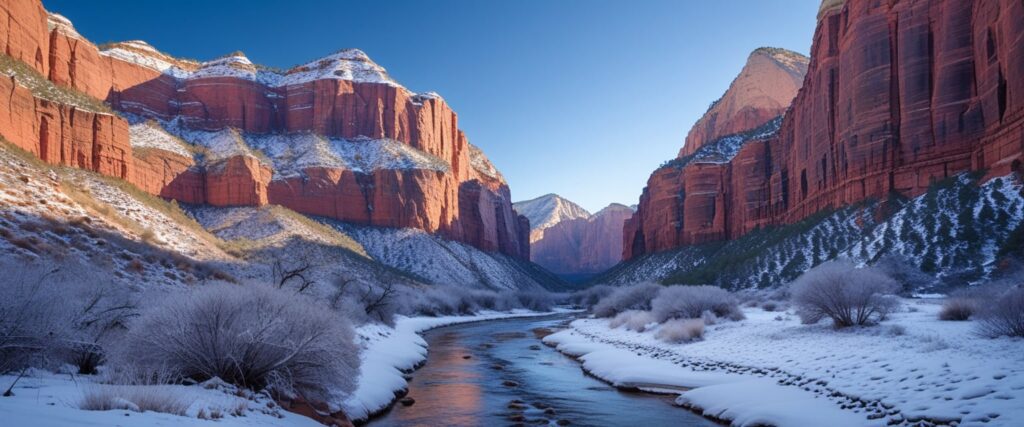
Travelers often combine Zion with nearby destinations. The drive from Las Vegas to Zion is straightforward, while routes from Salt Lake City or even the Grand Canyon connect multiple national parks in one trip. With a variety of lodging options inside and near the park, plus guided tours for those who want expert insight, Zion offers flexibility for every type of visit.
Zion National Park in December: What to Expect
December in Zion National Park brings colder weather, lighter crowds, and easier access by car into Zion Canyon. Visitors can expect crisp mornings, scenic sandstone cliffs dusted with snow, and a quieter experience compared to the busy summer months.
Weather and Scenic Beauty
Daytime highs in Zion Canyon average in the low 50s °F, while nights drop near freezing. At higher elevations such as Kolob Canyons, temperatures are several degrees colder. Rain and occasional snow are common, and snow often melts quickly in the lower canyon.
The contrast of white snow against red sandstone cliffs creates striking views. Icicles and frozen waterfalls sometimes appear along shaded rock formations. Photographers often find December rewarding, especially at sunrise when the cliffs glow in soft winter light.
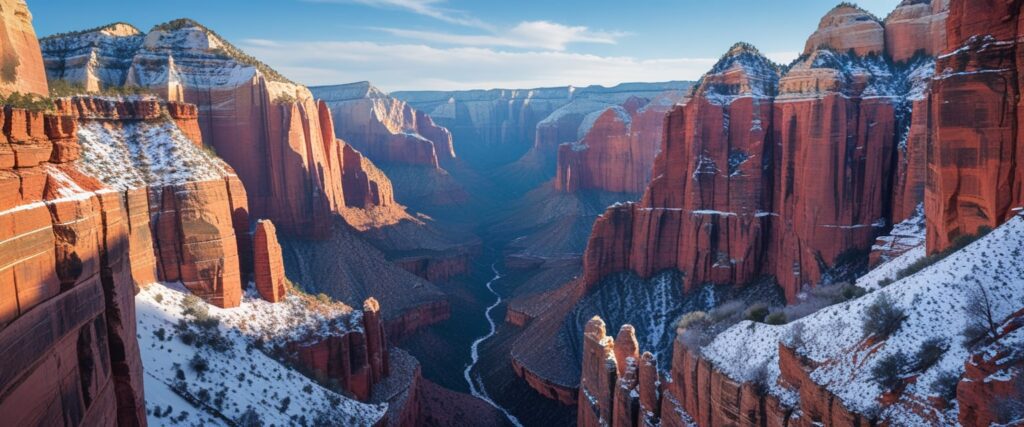
Although snow is less frequent inside the main canyon, nearby plateaus and overlooks may hold more accumulation. Visitors should bring warm clothing in layers since conditions shift quickly between sunlit areas and shaded trails.
Winter Travel Tips and Safety
Roads in the park are plowed, but icy patches can form overnight. Drivers should watch for black ice, especially in shaded curves of the scenic drive. Hiking trails may also close if ice or falling rock becomes a hazard.
Traction devices such as microspikes are recommended for steeper or shaded trails. Waterproof boots and trekking poles add stability on slick ground. Those without winter hiking experience should stick to easier paths like the Pa’rus Trail or Riverside Walk.

Camping is possible but requires proper cold-weather gear. Freezing nights, limited water sources, and fire restrictions make it a challenge. Visitors should check conditions at the Zion Visitor Center before setting out.
Crowds and Park Accessibility
One of the biggest advantages of December is reduced visitation. Popular areas like the scenic drive through Zion Canyon are far less crowded, making parking and trail access easier. Unlike summer, private vehicles can drive beyond Canyon Junction without relying on the Zion shuttle.
Lodging in Springdale and nearby towns is usually more available and often less expensive. Trails that are open feel quieter, allowing for more solitude. Wildlife such as deer and bighorn sheep are also easier to spot in the valley when fewer visitors are around.

Museums and the visitor center remain open, offering indoor exhibits and films when weather turns unfavorable. This mix of open access and lighter crowds makes December a unique time to explore the park.
Best Hikes and Activities in Zion National Park
Zion National Park offers a wide range of trails and activities that suit both seasoned hikers and casual visitors. From steep climbs with dramatic views to calm riverside walks, the park combines scenic beauty with accessible exploration. Visitors can also join guided tours for deeper insight into the park’s history and geology.
Top Winter Hikes
Winter hiking in Zion is quieter and often more comfortable due to cooler temperatures. Trails like the Canyon Overlook Trail remain accessible and reward hikers with sweeping views of Zion Canyon. The Emerald Pools Trail is another year-round favorite, though ice can form on shaded sections, so traction gear is helpful.
The Riverside Walk Trail is a paved path leading to the start of The Narrows. In December, The Narrows can still be hiked, but cold water requires dry suits and neoprene socks. Adventurous hikers often find this season less crowded.
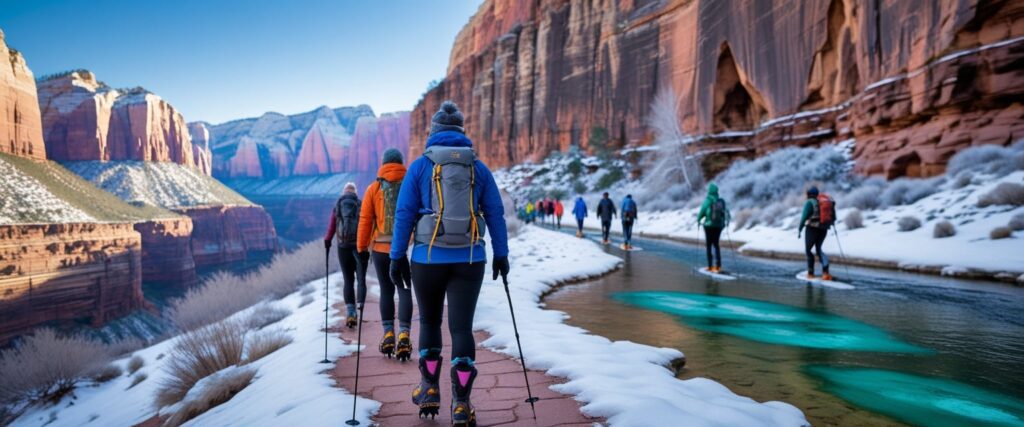
Those seeking solitude can explore the Chinle Trail or Taylor Creek Trail in Kolob Canyons, where cooler weather makes longer treks more manageable. According to this winter hiking guide, snow-dusted cliffs and open trails highlight the park’s off-season beauty.
Iconic Trails and Landmarks
Some trails define the Zion hiking experience. Angels Landing is one of the park’s most famous hikes, known for its steep switchbacks called Walter’s Wiggles and chain-assisted climb to the summit. A permit is required year-round, and winter conditions can make the climb icy.
The Narrows remains another iconic hike, where visitors wade through the Virgin River between towering canyon walls. The West Rim Trail and East Rim Trail also offer expansive views across Zion’s cliffs and valleys, connecting hikers to landmarks like Echo Canyon and Cable Mountain.

For sweeping panoramas without extreme effort, the Observation Point via the East Mesa Trailhead provides one of the best overlooks in the park. Landmarks along the Zion Canyon Scenic Drive, such as the Court of the Patriarchs and the Great White Throne, are also must-sees for visitors exploring by shuttle or car.
Easy and Family-Friendly Walks
Families often enjoy shorter, accessible trails. The Pa’rus Trail is a paved path that begins near the visitor center and follows the Virgin River, making it ideal for strollers, wheelchairs, and bikes.
The Weeping Rock Trail is a short but steep walk leading to a rock alcove with dripping springs, though it is sometimes closed due to rockfall. Similarly, the Grotto Trail connects the Grotto picnic area to Zion Lodge, offering a flat and easy route.
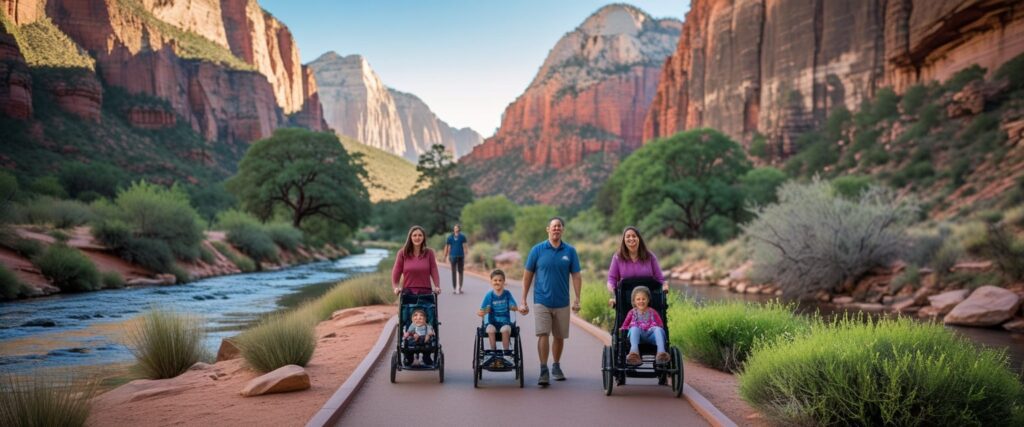
Other simple options include the Watchman Trail, which climbs gently to a viewpoint of Watchman Mountain, and the Canyon Overlook Trail, which is short but provides one of the best sunrise or sunset views in Zion. These trails allow visitors to enjoy the scenery without committing to longer hikes.
Private and Guided Tours
Private tours provide structured experiences for those who want expert guidance. Local outfitters lead hikes into areas like The Subway or slot canyons that require technical skills. These tours often include safety equipment and knowledge of trail conditions.
Guided photography tours help visitors capture sunrise over the Watchman or the red cliffs along Kolob Terrace Road. Some tours focus on geology and history, explaining formations like the Zion-Mount Carmel Tunnel or the cultural significance of the park’s landmarks.
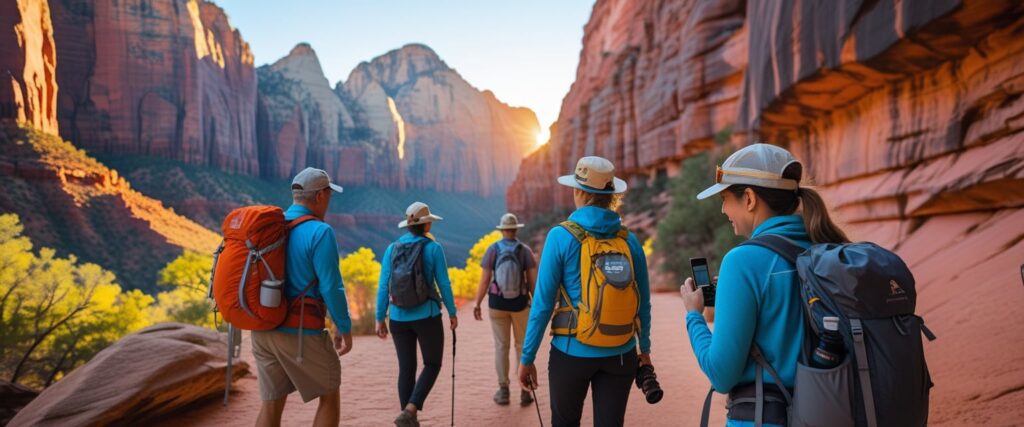
Visitors can also join shuttle-based sightseeing tours of Kolob Canyons and the main canyon. For those seeking a more personalized experience, private guides tailor hikes to fitness levels and interests, making it easier to explore Zion’s highlights without the stress of planning.
Conclusion
Experiencing Zion National Park in December means stepping into a quieter, more magical version of this iconic destination. With reduced crowds, open scenic drives, and trails highlighted by winter beauty, Zion National Park in December is a rewarding choice for both first-time visitors and seasoned adventurers. From iconic hikes like Angels Landing to easy riverside walks, exploring Zion National Park in December offers something for every traveler.
The colder weather adds a special charm, making Zion National Park in December ideal for those who enjoy solitude and photography. With nearby airports, lodging options, and guided tours, planning your visit to Zion National Park in December becomes simple and stress-free. Whether you’re drawn to the peaceful trails or the stunning snow-capped cliffs, Zion National Park in December ensures memories that last a lifetime.
Frequently Asked Questions
What is the weather like at Zion National Park in December?
Winters in Zion are generally cold and often wet. In Zion Canyon, average high temperatures are only about 50–53°F (10–12°C) and lows drop near or below freezing. It typically rains or snows a few days each month, though snow rarely stays long at low elevations. Always dress in warm layers and check the forecast – conditions can change quickly between sunny and icy.
Is Zion National Park open to visitors in December, and can I drive in the canyon?
Yes. The park remains open year-round. In winter the Zion Canyon Scenic Drive is plowed and open to private vehicles from November through March (unlike summer, when shuttles are required). Shuttle buses typically run only during busy holiday periods. Most visitor facilities (visitor center, museum) are open, but note that some high-elevation roads or trails (e.g. the upper Kolob Terrace Road) may close after winter storms and icy trails can be hazardous.
How crowded is Zion in December?
December is the quiet off-season. Visitor numbers drop sharply, so you’ll find far fewer people on the trails. The canyon is often described as peaceful and empty (winter is a time of “solitude” in Zion. With smaller crowds, parking and lodging are easier to find, and shuttle lines are short or not needed. In short, expect more space to enjoy the park.
What should I pack or what gear do I need for hiking in December?
You should be prepared for cold, potentially icy conditions. Wear warm, layered clothing and waterproof footwear. Bring traction devices (microspikes or crampons) for icy trail sections. Trekking poles can add stability. If you plan to hike The Narrows, you’ll need a drysuit and warm socks because the river is extremely cold. As always, carry extra water, snacks, and check current conditions before heading out.
Which hikes or activities are recommended in Zion during December?
Many lower-elevation trails remain open in winter. Short scenic hikes like Canyon Overlook and Watchman Trail are excellent – you can often catch sunrise or sunset with fewer people. The paved Pa’rus Trail and Riverside Walk are flat and family-friendly (year-round). You can still drive the four scenic roads (Zion Canyon, Kolob Canyons, Kolob Terrace, Mt. Carmel Highway) – for example, the Zion Canyon Scenic Drive is open to cars. Note that higher or steeper hikes (like Angels Landing) are usually icy and not recommended without experience and gear (see next Q).
Which trails are family-friendly or easy in Zion during winter?
For all ages, the Pa’rus Trail and Riverside Walk are excellent options. Both are paved, relatively flat, and handicap-accessible, and they remain open even in winter. The Canyon Overlook Trail (about 1 mile) is short and typically snow-free, offering great views. (The popular Weeping Rock trail just reopened on Sept. 5, 2025 after rockfall repairs, but Hidden Canyon and the East Rim route to Observation Point are still closed. Check current alerts before you go.)
What are the best airports for visiting Zion National Park?
The closest major airport is Las Vegas Harry Reid International (LAS), about a 170-mile drive (roughly 2.5 hours) to Zion. A smaller option is St. George Regional Airport (SGU), only ~50 miles (45 minutes) from the park, but it has far fewer flight choices. Salt Lake City (SLC) is farther (around 300 miles, ~4.5 hours) but can work if you’re touring other Utah parks. Choose based on flight availability and your travel plan.
When is the best time to visit Zion National Park?
Spring (March–May) and fall (Sept–Nov) are often ideal – mild temperatures and smaller crowds. However, winter (Dec–Feb) has its advantages: far fewer visitors and snowy scenery, though the weather is colder and some trails or roads may close. Summer (June–Aug) is hot and busy; Zion Canyon then requires the shuttle bus. It depends on whether you prefer solitude (winter) or warmer hiking weather (spring/fall).
Are any major trails or areas closed in winter 2025/2026?
Yes. Notably, Weeping Rock Trail – which has a dripping spring and hanging gardens – was closed after a 2023 rockfall but reopened on Sept. 5, 2025. (This gives families another short trail to enjoy.) However, Hidden Canyon Trail and the upper East Rim (Observation Point) remain closed through 2025 for safety. Also, parts of Kolob Canyons or Kolob Terrace Road may close during winter weather. Always check Zion’s alerts for the latest closures before you visit.
